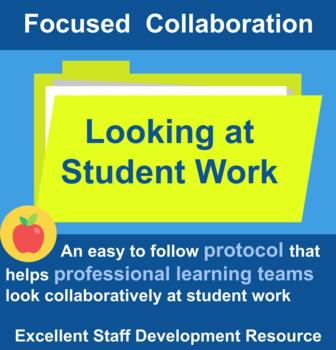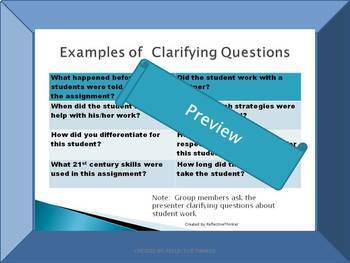A Protocol to Facilitate Collaboratively Looking at Student Work on PowerPoint
- PPTX
Description
Do you need a best practice idea for a back to school staff development or professional learning team or collaborative inquiry session? This 15-slide, editable PowerPoint with slide notes and instructions outlines an 8-step protocol for improving instruction and looking at student work. It was designed as a tool to help teachers with data-driven decision making about instruction to better meet the needs of students. The PowerPoint can be used in a staff or professional development session or at a collaborative group or professional learning team session when the group’s purpose is to engage in purposeful, in-depth, and insightful discussions concerning students’ work as well as teaching and learning. The protocol creates a structure and provides guidelines for looking at student work and teaching practices with the purpose of refining or improving classroom instruction.
What does looking collaboratively at student work look like? A group of 4-8 professionals assemble together to look at student work or lesson plan units to determine how to better help students and/or improve instructional practices. In a 45-minute or 1 hour session, the group uses the 8-Step protocol described in this PowerPoint as a collaboration tool or guide. A facilitator, specifically, uses the PowerPoint to guide the group's session. As the group looks at a classroom assignment, lesson plan, or student work, the group members ask questions and offer insightful comments and feedback. In the first session together, staff can be trained on the 8-step protocol. After that, teachers use the protocol in small group sessions or learning teams using their lesson plans or examples of student work to inform and improve their 21st century teaching and student learning.
Items outlined in this Powerpoint are the following:
Purpose Slide
Who and What? Slide
Selection of facilitator and timekeeper Slide
Facilitator introduction Slide
Presentation of Student Work Slide
Presenter Questions
Clarifying Questions
Group discussion: Description of work
Group discussion: Feedback
Presenter Reflection Slide
Debriefing Slide
Next Steps to Improve Instruction Slide
Instructional NOTES provided underneath slides
Preview Available.
Browse in my TPT store for other 21st century teaching and learning resources.
A Protocol to Facilitate Collaboratively Looking at Student Work on PowerPoint is licensed under a Creative Commons Attribution 3.0 Unported License.





